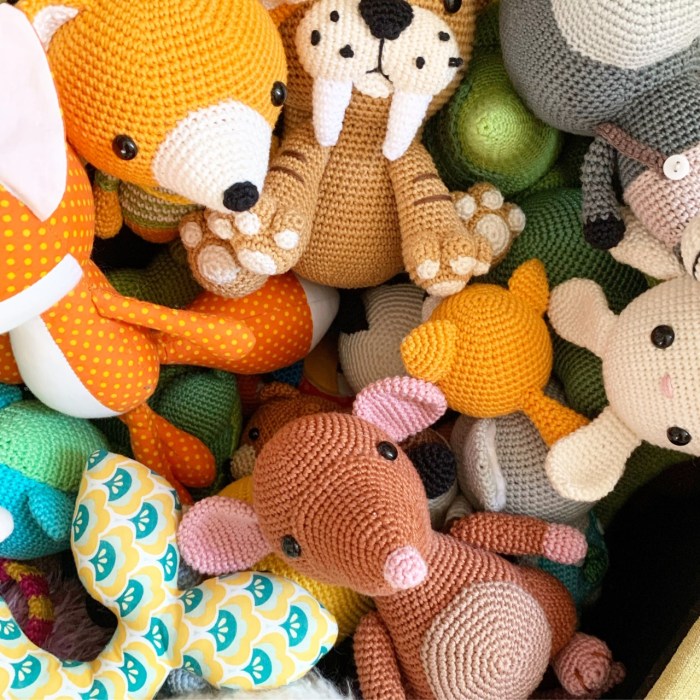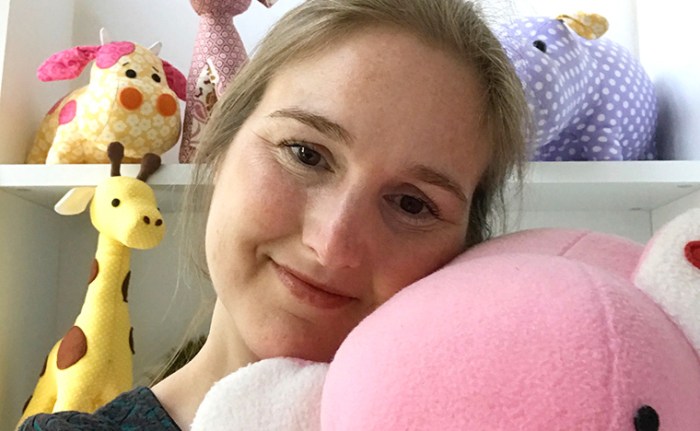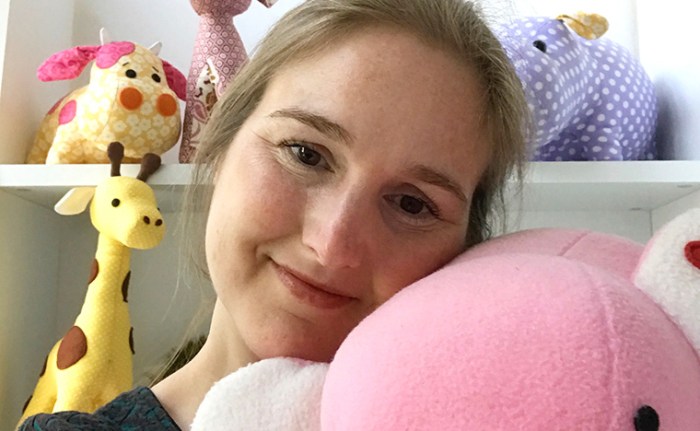DIY Fluffies sets the stage for a captivating exploration of the world of handcrafted plush toys. From the humble beginnings of this creative movement to its burgeoning popularity, we delve into the fascinating story of how people are bringing their imaginative visions to life with fluffy, lovable companions.
Table of Contents
This guide provides a comprehensive overview of everything you need to know about DIY fluffies, from choosing the right materials and mastering basic techniques to designing unique creations and nurturing a thriving community. Whether you’re a seasoned crafter or a curious beginner, there’s something here for everyone who enjoys the joy of creating and the comfort of soft, cuddly companions.
The Rise of DIY Fluffies
The DIY fluffy movement, a phenomenon centered around creating and caring for plush toys resembling fictional creatures called “fluffies,” has experienced a rapid surge in popularity. This movement, originating within online communities, has evolved into a multifaceted phenomenon encompassing artistic expression, creative experimentation, and even ethical considerations.
Origins and Evolution
The DIY fluffy movement emerged from the “fluffy” fandom, a subculture rooted in the fictional depiction of these creatures. Initially, fluffies were primarily depicted in written narratives, often with themes of anthropomorphism and social commentary. However, the desire to bring these creatures to life physically led to the development of DIY fluffy creation. Early efforts involved modifying existing plush toys or using simple sewing techniques to craft rudimentary versions. Over time, the movement evolved, incorporating more sophisticated materials, patterns, and techniques.
Factors Contributing to Popularity
Several factors have contributed to the growing popularity of DIY fluffies.
- Accessibility: The relative ease of creating DIY fluffies, requiring basic sewing skills and readily available materials, has made the movement accessible to a wide range of individuals.
- Creativity and Expression: The ability to personalize and customize fluffies allows for a vast spectrum of artistic expression, catering to diverse preferences and interests.
- Community and Connection: Online communities dedicated to DIY fluffies have fostered a sense of belonging and shared passion among enthusiasts, facilitating knowledge sharing, collaboration, and inspiration.
Ethical Considerations
The rise of DIY fluffies has also raised ethical concerns, particularly regarding the potential for animal cruelty and the blurring of lines between fantasy and reality.
- Misinterpretation and Misuse: There have been instances of individuals misinterpreting the fictional nature of fluffies and attempting to apply real-world animal care practices to their creations, leading to potential harm.
- Blurring of Boundaries: The realistic appearance of some DIY fluffies can blur the line between fantasy and reality, potentially desensitizing individuals to the needs and well-being of actual animals.
- Responsibility and Awareness: The DIY fluffy movement underscores the importance of responsible creation and engagement, promoting ethical considerations and awareness of the potential impact on animal welfare.
Types of DIY Fluffies
DIY fluffies, a creative and engaging hobby, offer a wide range of possibilities for crafting adorable and personalized plush creatures. From simple to intricate, these projects cater to various skill levels and preferences. This section explores the different types of DIY fluffies, their construction methods, and their advantages and disadvantages.
Types of DIY Fluffies
The types of DIY fluffies can be broadly categorized based on their materials and construction methods. Here are some popular options:
- Sewn Fluffies: These are the most traditional and versatile type of DIY fluffies. They are made by sewing together fabric pieces, typically using a sewing machine or hand stitching. Sewn fluffies offer a wide range of customization options, allowing for intricate details and unique designs. Popular materials for sewn fluffies include fleece, plush fabric, felt, and even repurposed clothing.
- No-Sew Fluffies: These are perfect for beginners or those who prefer a quicker and easier method. They are made using various no-sew techniques, such as glue, hot glue, or fabric adhesive. No-sew fluffies are typically simpler in design but can still be incredibly cute and expressive. Popular materials for no-sew fluffies include felt, foam, and even recycled materials like cardboard or plastic bottles.
- Crocheted Fluffies: These are created using crochet techniques, which involves using a hook to loop yarn together to form a fabric. Crocheted fluffies offer a unique and textured appearance, with a wide range of possibilities for color and pattern combinations. They are typically more time-consuming than other methods but can be incredibly detailed and intricate.
- Knitted Fluffies: Similar to crocheted fluffies, knitted fluffies are made using knitting needles to create a fabric from yarn. Knitting offers a smooth and even texture, making it ideal for creating soft and cuddly fluffies. Like crocheted fluffies, knitted fluffies require some skill and patience, but the results can be stunning.
- Sculpted Fluffies: These fluffies are created using sculpting techniques, typically with materials like clay, polymer clay, or even paper mache. Sculpted fluffies allow for intricate details and unique shapes, making them ideal for creating realistic or fantasy-inspired creatures. While they require some artistic skill, they offer a unique and rewarding creative experience.
Advantages and Disadvantages
Each type of DIY fluffy has its own set of advantages and disadvantages:
| Type | Advantages | Disadvantages |
|---|---|---|
| Sewn Fluffies | Versatile, customizable, durable, wide range of materials | Requires sewing skills, can be time-consuming |
| No-Sew Fluffies | Quick and easy, beginner-friendly, minimal tools required | Limited design options, may not be as durable |
| Crocheted Fluffies | Unique texture, wide range of color and pattern options, durable | Requires crochet skills, can be time-consuming |
| Knitted Fluffies | Smooth and even texture, soft and cuddly, durable | Requires knitting skills, can be time-consuming |
| Sculpted Fluffies | Intricate details, unique shapes, realistic or fantasy-inspired designs | Requires sculpting skills, can be messy, may not be as durable |
Popular DIY Fluffy Designs and Techniques
The world of DIY fluffies is constantly evolving, with new designs and techniques emerging regularly. Some popular DIY fluffy designs and techniques include:
- Simple Plush Toys: These are typically small and easy to make, often featuring basic shapes like circles, squares, or triangles. They are perfect for beginners and can be customized with different colors, patterns, and embellishments.
- Character Fluffies: These are inspired by popular characters from movies, TV shows, books, or video games. They can be intricate and detailed, requiring advanced sewing or sculpting skills.
- Fantasy Creatures: These are inspired by mythical creatures like dragons, unicorns, and fairies. They often feature unique shapes, textures, and colors, making them visually stunning.
- Amigurumi: This Japanese technique involves crocheting small, stuffed animals or figures. Amigurumi fluffies are known for their adorable and detailed designs, often featuring realistic features and intricate patterns.
- Freeform Crochet: This technique allows for creative freedom, allowing you to create unique and abstract shapes and designs. Freeform crocheted fluffies can be whimsical and playful, offering endless possibilities for personalization.
Materials and Tools

Creating DIY fluffies requires a variety of materials and tools, ranging from basic crafting supplies to specialized equipment. The selection of materials and tools depends on the desired complexity and style of the fluffy. This section explores the essential materials and tools needed, their properties, and budget-friendly options.
Materials
The core materials for DIY fluffies are yarn, stuffing, and felt. Each material plays a crucial role in shaping the fluffy’s appearance and texture.
- Yarn: Yarn is the primary material for creating the fluffy’s fur. Different types of yarn offer distinct textures and appearances. For example, plush yarn creates a soft and cuddly feel, while chenille yarn provides a more textured and fluffy look. The choice of yarn depends on the desired appearance and the level of skill. For beginners, plush yarn is recommended for its ease of use.
- Felt: Felt is a versatile material used for creating the fluffy’s eyes, nose, and other details. It is available in various colors and thicknesses, allowing for creative customization. Felt is also easy to cut and shape, making it ideal for beginners.
- Stuffing: Stuffing provides the fluffy’s body with volume and shape. Common stuffing materials include polyester fiberfill, cotton batting, and even recycled materials like old clothing. Polyester fiberfill is the most popular choice due to its affordability and ease of use. Cotton batting offers a softer feel, while recycled materials provide a more sustainable option.
Tools
A basic set of tools is essential for creating DIY fluffies. These tools are readily available and can be found at most craft stores.
- Sewing Needle and Thread: These are used for sewing the fluffy’s body and attaching details. Choose a needle size appropriate for the yarn used, and use a strong thread that matches the yarn color.
- Scissors: Sharp scissors are essential for cutting yarn, felt, and fabric.
- Sewing Machine (Optional): A sewing machine can speed up the process of sewing the fluffy’s body. However, it is not essential for beginners.
- Hot Glue Gun: A hot glue gun is useful for attaching details like eyes, nose, and ears. It provides a strong and quick bond.
- Safety Pins: Safety pins are helpful for temporarily securing pieces together before sewing.
Sourcing Materials and Tools
Materials and tools for DIY fluffies can be sourced from various places, including craft stores, online retailers, and even thrift stores. Craft stores like Michaels, Hobby Lobby, and Joann Fabrics offer a wide selection of yarn, felt, stuffing, and tools. Online retailers like Amazon and Etsy provide convenient access to a vast array of materials and tools. Thrift stores can be a great source of budget-friendly yarn, felt, and stuffing.
Tip: Look for sales and discounts to save money on materials and tools.
Care and Maintenance

Just like any other craft project, DIY fluffies require proper care and maintenance to ensure their longevity and keep them looking their best. This section will guide you through the essential steps for washing, drying, and storing your DIY fluffies, along with tips for repairing any minor damage that may occur over time.
Washing
Washing DIY fluffies is crucial to maintaining their cleanliness and preventing the accumulation of dust, dirt, and other debris. Here are the steps for washing your DIY fluffies:
- Choose a gentle detergent: Use a mild detergent specifically designed for delicate fabrics or baby clothes. Avoid harsh detergents that can damage the fluffies’ fibers.
- Hand wash or use a gentle cycle: If possible, hand wash your DIY fluffies in a basin of lukewarm water. If using a washing machine, select the gentlest cycle and use cold water.
- Avoid wringing or twisting: Gently squeeze out excess water from the fluffies. Avoid wringing or twisting them as this can damage the fibers.
- Rinse thoroughly: Rinse the fluffies thoroughly with clean water to remove all traces of detergent.
Drying
Proper drying is essential to prevent mold and mildew growth. Here are the best practices for drying your DIY fluffies:
- Air dry: The best way to dry DIY fluffies is to air dry them. Gently squeeze out excess water and lay them flat on a clean towel or drying rack. Avoid direct sunlight as it can fade the colors.
- Avoid heat: Do not use a dryer or iron to dry DIY fluffies. The heat can damage the fibers and cause shrinkage.
- Turn regularly: Turn the fluffies regularly during drying to ensure even drying and prevent mildew.
Storing
Proper storage can help preserve your DIY fluffies and keep them looking their best. Here are some tips for storing your DIY fluffies:
- Clean and dry: Ensure the fluffies are clean and completely dry before storing.
- Store in a cool, dry place: Avoid storing DIY fluffies in humid or damp environments.
- Use airtight containers: Store the fluffies in airtight containers to prevent dust and moisture from damaging them.
- Avoid direct sunlight: Store the fluffies in a dark or dimly lit area to prevent fading.
Repairing Damage
Minor damage to DIY fluffies can be easily repaired. Here are some tips for repairing damaged fluffies:
- Sewing: Use a needle and thread to sew up any tears or holes. Choose thread that matches the color of the fluffies as closely as possible.
- Fabric glue: Use a fabric glue to secure loose seams or mend small tears. Apply a small amount of glue and press firmly.
- Replacing stuffing: If the stuffing has become lumpy or worn out, you can replace it with new stuffing. Carefully open the fluffies and remove the old stuffing. Fill the fluffies with new stuffing and sew them back together.
The Future of DIY Fluffies
The DIY fluffy movement, fueled by passion, creativity, and a growing community, is poised for exciting developments. The future of DIY fluffies is filled with potential for innovation, technological advancements, and an evolving role in the broader creative landscape.
Emerging Trends and Innovations in DIY Fluffy Creation
The DIY fluffy community is constantly evolving, with new trends and innovations emerging regularly. This dynamism is driven by the desire to push creative boundaries and explore new possibilities in fluffy creation.
- Advanced Materials: The use of innovative materials, such as silicone, resin, and 3D printing filaments, is expanding the range of possibilities for DIY fluffies. These materials offer greater durability, realism, and customization options, allowing creators to bring their visions to life with greater detail and precision.
- Customizable Kits and Patterns: Pre-designed kits and patterns are becoming increasingly popular, offering aspiring creators a streamlined and accessible entry point into the world of DIY fluffies. These kits often include pre-cut materials, detailed instructions, and even specialized tools, making the creation process more manageable and enjoyable for beginners.
- Collaborative Projects: The rise of online communities and social media platforms has fostered a collaborative spirit among DIY fluffy enthusiasts. Creators are increasingly working together on ambitious projects, sharing their skills, knowledge, and resources to create unique and complex pieces that would be difficult to achieve individually.
The Potential Impact of Technology on the DIY Fluffy Movement
Technology is playing a transformative role in the DIY fluffy movement, enabling greater accessibility, creativity, and innovation.
- 3D Printing: 3D printing is revolutionizing DIY fluffy creation by offering a highly customizable and precise method for creating intricate shapes, details, and even entire fluffy bodies. The ability to design and print custom molds and parts allows for greater flexibility and originality in fluffy designs.
- Virtual Reality (VR) and Augmented Reality (AR): VR and AR technologies have the potential to revolutionize the design and creation process for DIY fluffies. VR tools can provide immersive and interactive design environments, allowing creators to visualize and manipulate their designs in 3D space. AR can enhance the creation process by providing real-time feedback and guidance, overlaying digital information onto the physical world.
- Artificial Intelligence (AI): AI-powered tools are emerging that can assist DIY fluffy creators with various tasks, such as generating design ideas, optimizing materials, and automating certain aspects of the creation process. AI can help creators explore new possibilities and streamline their workflow, enabling them to focus on the creative aspects of their work.
DIY Fluffies and Society
DIY fluffies, a burgeoning subculture, are not just whimsical creations; they represent a unique intersection of craft, technology, and social interaction. Their appeal lies in their ability to spark creativity, foster connection, and offer a platform for self-expression.
The Cultural Significance of DIY Fluffies
The rise of DIY fluffies reflects a growing interest in personalized and handmade objects. In a world dominated by mass-produced goods, crafting your own fluffy allows for unique customization and a sense of ownership. This resonates with a desire for individuality and a rejection of generic, mass-produced items.
Therapeutic and Educational Benefits
DIY fluffy creation offers numerous therapeutic and educational benefits. The process of designing, sewing, and assembling a fluffy can be calming and meditative, providing a creative outlet for stress relief. The experience can also enhance fine motor skills, problem-solving abilities, and patience. Additionally, the creation of DIY fluffies can be a valuable learning tool for understanding basic sewing techniques, material properties, and the principles of design.
Relationship with Other Creative Expressions
DIY fluffies are not isolated from other creative and artistic expressions. They often serve as a canvas for artistic expression, with individuals customizing their fluffies with unique patterns, colors, and embellishments. The creation of DIY fluffies can also inspire other forms of art, such as photography, illustration, and writing.
The DIY fluffy movement is a testament to the enduring power of creativity and the joy of bringing imagination to life. By combining simple techniques with endless possibilities for customization, anyone can become a creator and share their passion for fluffy creations with the world. So, gather your materials, unleash your creativity, and embark on your own journey of crafting lovable DIY fluffies.
DIY fluffies are a great way to express creativity and personalize your space. From fluffy pillows to decorative accents, the possibilities are endless. For a more adventurous project, you might consider building a DIY elastic band gun , which can be a fun and challenging project for those who enjoy working with mechanics. After all, the skills you learn from building a DIY elastic band gun can be applied to many other projects, including crafting your own fluffy creations.


